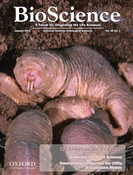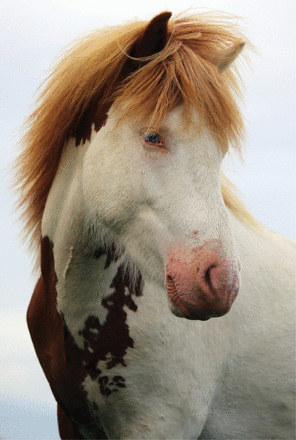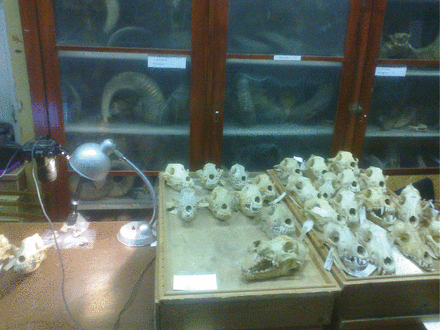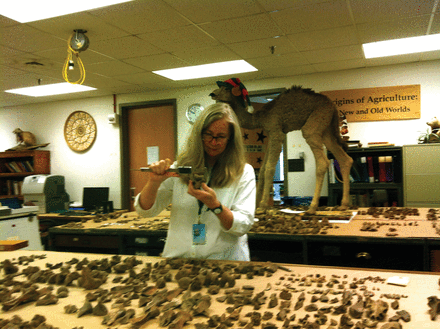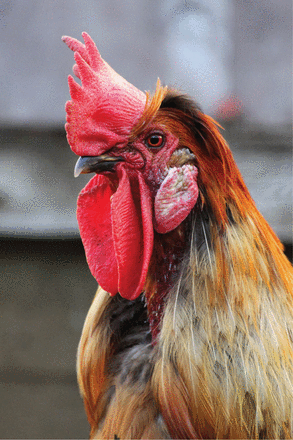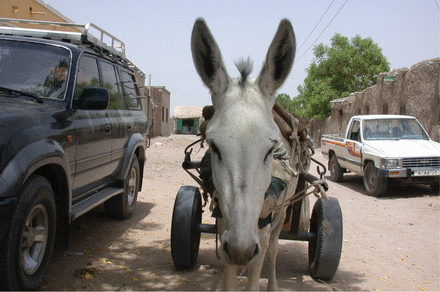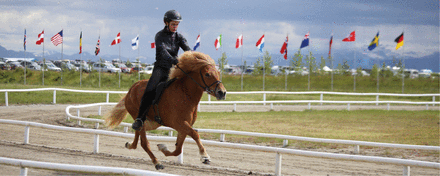-
PDF
- Split View
-
Views
-
Cite
Cite
Richard Blaustein, Unraveling the Mysteries of Animal Domestication: Whole-genome sequencing challenges old assumptions, BioScience, Volume 65, Issue 1, January 2015, Pages 7–13, https://doi.org/10.1093/biosci/biu201
Close - Share Icon Share
Advances in genetics are enabling researchers to dramatically amend earlier narratives of animal domestication and raise new questions about how and when humans first interacted with animals. In particular, whole-genome sequencing, made much more accessible and inexpensive in recent years, is illuminating the trajectories of animals such as horses, chickens, pigs, and rabbits.
Moreover, these animal domestication narratives are more nuanced than those offered by earlier genetic sketches. For example, scholars now think that many species had an extended period of mixing domestic and wild populations—lasting even thousands of years in some cases. Furthermore, although a few notable signatures of animal domestication, such as coat color, are associated with single or very few genetic mutations, the key behavioral changes that most distinguish a domestic animal from a wild one—that is, tameness, a reduction of wariness, and a lack of aggression—appear to come from multiple genetic changes.
There is little color variety among wild horses but much in domestic breeds. Different colors come from genetic mutations and variation, helped along by human preferences. Photograph: Freyja Imsland.
Many questions remain, but there is clearly a robust, new discourse, with genetics offering insights into both the trajectories of animal domestication and the workings of selection within evolution.
Organizing the domestication pathways
Certain features distinguish a domestic animal from its wild relatives. Differing coat or feather color, such as with horses, pigs, and chickens; overall body size reductions and reduced brain size in many species; increased reproductive cycles, especially with edible domestics such as chickens; shortened snouts and crowded teeth, which are pronounced in dogs, are often highlighted traits of domestic animals.
But these signatures—at least their timing and implications—have been called into question. Melinda A. Zeder, senior research scientist and curator of Old World archaeology and archaeozoology at the National Museum of Natural History, for example, has challenged what was formerly an axiom—that reduced body size is a clear marker of animal domestication. Researchers, finding smaller animal bones at ancient human sites, had figured that these animals were smaller because of the morphological changes caused by domestication. But Zeder, motivated to get “a window into the actual relationship between the humans and the animals and their economic goals in utilizing those animals,” probed deeper and explored whether the smaller bones might be signs not of morphological change but, rather, an incipient change from “a hunter's strategy of maximizing immediate return to a herder's interest in prolonging and fostering the herd itself.”
Zeder examined the bones of goats and sheep from Near East sites. She studied the sexes of the specimens and looked for postcranial bones fusions, which indicate the ages of the animals when they were killed; younger animals have unfused postcranial bones. She discovered a shift toward humans’ harvesting younger individuals with smaller bones. She explains that humans, who, earlier, hunted larger, older, male animals, started to kill mostly young, smaller males when the hunters transitioned to protoherding methods, prizing the females for sustaining herds.
Perhaps the most elusive domestication question is how species as diverse as dogs, pigs, horses, donkeys, and chickens acquired the characteristics of tameness, a lack of aggressiveness, and lessened wariness. How each species genetically obtained their distinct traits is also key to understanding domestication.
Geneticist Greger Larson collects dog and wolf specimens from around the world. These came from a 2014 trip to the former Soviet Union. Larson says that the new work on animal domestication represents “consilience” of genetics and archaeology. Photograph: Greger Larson.
To help with the inquiry, in a 2012 paper, “The domestication of animals,” in the Journal of Anthropological Research, Zeder offered a model of three primary pathways to domestication: the commensal pathway, the prey pathway, and the directed pathway.
In the commensal pathway (so named for food sharing between humans and animals), certain individuals of a species—most famously, domestic dogs’ wolf ancestors—appear to have been attracted to human settlements to scavenge for food or to find some kind of support.
Unlike other animals, dogs are found at archaeological sites that precede agriculture. University of Oxford geneticist Greger Larson is collecting bones of ancient dog and wolf samples from all over the world. Dog domestication going back 15,000 years is solidly established, he says, and some archaeologists go much further, dating dog domestication as far back as 30,000 years. Leif Andersson, an animal geneticist with a domestication lab at the University of Uppsala, in Sweden, says that it is possible that those less wary dog ancestors might have had a genetic mutation that was selected for (favored) by the unique commensal relationship between humans and dogs.
Zeder's second domestication pathway, the prey pathway, pertains to animals that humans first hunted then progressively managed, such as goats, sheep, and cattle. Zeder explains that humans increasingly modified the environments that they shared with animals. “Humans begin to play around with different hunting strategies or different ways of manipulating environments that might, in the end, increase the yield or the predictability of capture,” she says. Burning, creating terraced environments that might attract browsers, and constructing tight places to capture migrating animals are some of the ecological manipulations that the hunters might have employed. “Through time and with greater familiarity with how those work, they begin to actively manage some portions of those animals.” She adds that the progressive corralling of these animals also might have eventually led to distinct phenotypic transformations, such as horn reduction and even height reduction, as the penned-up farming environments favored the changes.
The third “directed” pathway, is, as Zeder writes, “a more deliberate and directed process—a process initiated by humans with the goal of domesticating a free-living animal to obtain a specific resource or set of resources of interest.” Horses and donkeys used for transport are strong examples that go back thousands of years. Zeder also points out that more recent domestications, such as furrier minks and, lately, with aquaculture, are examples of directed pathway domestication.
She and Larson both point out that some species’ domestication crisscrosses more than one category, such as pigs, who might have had a combined commensal–prey pathway. Still, Larson says, “having those pathways clarified and discussed in that particular way really clarifies the entire [domestication] field… We are now actually closer to understanding how the process would have taken place without getting confounded by the conflation of those three things, which it has been for decades.” Zeder's three-pathway paradigm also brings together archaeologists and geneticists.
This decade, while Zeder has been presenting her new paradigm, genomic capabilities have expanded the field of domestication research. “The development of molecular genetics has opened the world for us to see which changes have occurred during domestication,” Andersson says. “And that has been particularly pronounced [during] the past 4▒years, with the development of new sequencing technologies.” Researchers now have access to rapid and inexpensive sequencing of the whole genome of a reference individual, as well as comparative sampling of a population's genome for noting similarities and variations.
Archaeologist Melinda A. Zeder is studying pig bones gathered from an 11,700-year-old site in the Fertile Crescent. At this early stage of examining demographic and harvesting patterns, she suggests that humans may have harvested female pigs with recent litters. This indicates more selectivity and strategy than has been found among earlier human hunting populations. Photograph: Reuven Yeshurun.
Andersson credits these advances to the National Institutes of Health–supported whole-genome work made public in 2001. Andersson notes that, although this effort has been driven by medical research, “this shift in technology has been a revolution for all things in biology, because you can apply this technology to any organism.” Chickens, horses, and rabbits are among the species that Andersson and his group have studied and about which they have published widely cited papers.
Larson, too, employs these newly accessible sequencing technologies. Larson is particularly noted for his investigations of ancient DNA. The sequencing revolution has enabled small bits of viable ancient DNA, which are often fragmentary and degraded, to be studied and compared with both modern samples and other ancient fragments. For example, Larson used ancient DNA to document that chickens in ancient Rome possessed the variant TSHR gene, which Andersson and his team had earlier discovered and which could be associated with the increased reproductive cycles of domestic chickens.
Importantly, the new technologies have made nuclear DNA accessible. Nuclear DNA contains numerous genes that are linked to many traits and overall genetic diversity. In the last decade, the focus was on mitochondrial DNA, which is passed along maternal lines. The study of mitochondria has strengths and limitations: The study of “mitochondrial [DNA] delivers a very nice population signature,” Larson explains, but “you really don't get anywhere close to the kinds of full-scale impressions or signature of admixture that you can do with a nuclear genome, which is now what we have access to.”
Giving an example of the change in capacities, Larson adds that, just 8 years ago, when he was working with the AC–GT base-pair building blocks of DNA, “the longest stretch of base pairs that I worked with was 700 base pairs, and my ancient DNA had only 80 base pairs.” He says that researchers can now get up to 250 million base pairs in a very short amount of time. “It is staggering,” Larson says. “It is going exponential. Everybody in the field is reeling.”
Mixing, introgressing
With this expanded genetic library, researchers now believe that wild and domestic populations had a long period of continuous mixing. Larson and his collaborators, such as archaeologist Dorian Fuller, hold that, historically, animals may have had limited numbers of domestication situations, followed by long periods of introgression—the process by which domestic animals acquire the genetic material of wild animals in their DNA.
Larson stresses that domestication is what occurs along one of Zeder's three pathways. “It is a long-term, multigenerational process,” he says. For introgression, Larson offers the example of the domestic pig in Europe—one of his current focuses—and its mixing with the European wild boar and the resultant boar-resembling pigs. Larson explains, “That means that when we look around and see… wild boar and other wild animals contributing stuff to domestic populations, it is not because of multiple domestic processes. It is because of one domestication process, followed by lots and lots of introgression with wild animals all over the place.”
Donkeys are another example of extended introgression. Albano Beja-Pereira, a geneticist at the University of Porto, in Portugal, who works on donkey domestication and on human lactose intolerance, and one of his colleagues, Washington University in St.▒Louis archaeologist Fiona Marshall, study the donkey and its ancestor, the wild ass, of which 400 remain, with one group in Eritrea and the other in Ethiopia. Not many researchers study donkeys, and Beja-Pereira and Marshall have made noted contributions. For example, focusing on mitochondria, Beja-Pereira led a study published in Science in 2004 (doi:10.1126/science.1096008) that established the East African ancestry of wild donkeys.
The whole genomic sequencing of the chicken was one of the first to be available to researchers. Descended from the red jungle fowl, domesticated chickens evolved to have different breeding trajectories for those that lay eggs for commerce and for those raised for meat. Photograph: Freyja Imsland.
Beja-Pereira and Marshall also work on wild ass conservation with Patricia Moehlman, the head of the International Union for Conservation of Nature's Species Survival Committee Equid Specialist Group. This collaboration enables Beja-Pereira to study the wild ass populations through noninvasive genetics, mainly by analyzing the feces of the wild asses. He has found that the two wild ass populations—although they are separated by over 1000 kilometers—do mix, which significantly contributes to their relative health. He adds that these wild asses and local donkeys do not mix today.
In the past, there was an extended history of introgression. Marshall says that cultures that had donkeys, such as in ancient Egypt and Rome, to some extent encouraged this mixing of wild asses and domestic donkeys. In another example, Marshall says that the Beja pastoralists of Sudan and other parts of Saharan East Africa “will historically tie females… near water points in arid areas, hoping that male wild asses will breed with them.” She explains that, “in a transport animal like a donkey, what people valued more than anything else is strength and resilience… You want them to be big and strong and to be able to cope with drought and stony conditions, which the wild animals have evolved to do.”
Donkey domestication is also linked to environmental change that has a contemporary resonance. Marshall explains that, around 12,000 years ago, rainfall shifted, and the Sahara became grasslands, which attracted human settlers. However, around 6000 years ago, the Sahara increasingly reverted to aridity, and people needed to move to find water and other sustenance. They turned to the wild ass for transport and support.
Donkeys are still much used in the developing world. Sequencing the donkey genome would have both positive social and positive scientific implications, but funders in wealthier nations have not yet wholeheartedly supported donkey genome research, according to Albano Beja-Pereira. Photograph: Albano Beja-Pereira.
“The donkeys are absolutely related to the aridity and the need to move,” explains Marshall. “The whole strategy of African pastoralism is to make use of scattered and fluctuating resources very effectively, and the donkey allowed the mobility to make that happen, because cattle are not resilient enough to put loads on and to move them when it is hot and dry.” Marshall and Beja-Pereira continue their research; Marshall is conducting a wild ass behavior study with the St. Louis Zoo, and Beja-Pereira is trying to get the Donkey Whole Genome Sequencing Consortium up and running. The findings of a wild ass and donkey genome would be useful, he says, and “a sense of diversity and the process that gave rise to distinct phenotypes” would be gained. He adds that the relationship and common ancestry of donkeys and horses would be illuminated. “The horse genome is available,” says Beja-Pereira, “so we just need to compare it.”
Dramatic findings: The horse and the rabbit
In addition to introgression, researchers also offer dramatic findings linking genes to traits, and these have been facilitated by the sequencing revolution.
Andersson and his colleagues have attracted much notice for two recent papers, one on domesticated horses, in Nature (doi:10.1038/nature11399), and another on rabbits, published in Science in August 2014 (doi:10.1126/science.1253714). In his horse study, Andersson says that it was a “big surprise when we were able to identify a single base change that was really critical for the gaits of horses. We thought it would be more complicated.”
Andersson and his team first looked at Icelandic horses because of their gait variations. All horses can do three gaits—the walk, the trot, and the gallop. Icelandic horses have a fourth gait, the tölt. In addition, half of these Icelandic horses can do pacing, in which the front and back side legs move back and forth in unison.
Andersson and his team studied 40 pacers and 30 nonpacers and found a genetic difference in the DMRT3 gene, a regulatory gene that directs codons to build a protein for neurons associated with locomotion. The mutation caused a stop codon, which stopped the neuron protein at 300 amino acids, preventing the full expression of 475 amino acids. “The protein cannot act in the proper faction,” Andersson explains. “You could say that you blunt the function of that protein.”
The effect on a horse with a mutated DMRT3 gene is that the mutation interferes with the horse's full muscle expression but yields a smoother ride for humans. Humans noticed the change and selected for it.
Andersson's team has not yet been able to determine when the mutation occurred. Archaeology can help answer this question, perhaps eventually finding horse remains in ancient sites. Andersson believes that the horse mutation and its human selection probably go back thousands of years. Certainly, the selection for the DMRT3 variation was strong; Andersson published a follow-up study of approximately 150 horse breeds, documenting the mutation in horses worldwide.
Andersson and his colleagues’ rabbit domestication study generated as much—if not more—interest. In this study, the researchers focused on tame behavior, the sine qua non of domestication.
Rabbit domestication goes back only about 1500 years. Wild rabbits remain, and their places of origin in Spain and France are known. The researchers focused on “6 different breeds of domestic rabbits, 3 pools of wild rabbits in southern France, and 11 pools of wild rabbits on the Iberian Peninsula. Although their conclusions were not as surprising as the gait study's were, the findings were pronounced. First, for rabbit domestication, the genetic changes did not include the fixation of mutation or gene deletion. The loss of genes for domestication was one often-hypothesized condition for domestication.
The DMRT3 gene mutation is key for producing horses that offer more comfortable rides. Humans have also selected against this mutation when they have wanted to breed qualities such as speed and strength. Racehorses and draft horses lack the mutation. Photograph: Freyja Imsland.
Changed variation in alleles—those possibilities of changed base-pair variation that inhere in genes—was the standout finding of the rabbit study. According to Andersson, this increased variation occurred on hundreds of genes. “For these changes, we observed it is very common that it is a shift in allele frequencies,” he says. “Many small changes together make a large difference.” He adds that the fact that it is not completely fixed means that there is a possibility for selection back to the wild form.
The rabbit paper characterizes genetics for tameness. However, it is only a beginning, and there are many caveats. Beja-Pereira, for example, says, “The rabbit has a very short story in terms of domestication” and has not spread all over the world as the donkey and the horse, who “have been under constant pressure all over the world, from different environments, different pathogens, and different weather conditions,” have.
Geneticist Leif Andersson has been researching animal domestication for more than 30 years. Whole-genome sequencing has greatly facilitated Andersson's work on chickens and horses, among other species. Photograph: Lars Wallin.
Other domestic species with longer histories might be expected to have as much—if not more—genetic domestication changes and variation.
With climate change, the past may be a prologue
Animal domestication researchers believe that the new genetics and robust discourse bodes well for the field. In the past, Zeder says, the work of geneticists and archaeologists was not mutually supportive. But today, geneticists such as Larson and Andersson appreciate that “the archaeologists are able to give the geneticists… an understanding [of] what that human–plant and –animal interaction process is—and [to] really talk about the nitty-gritty of what domestication is.”
Geneticists can help archaeologists, too, especially with what Zeder calls the “how we got to where we are” question. “I can think of very few thresholds that are as significant as the origins of plants and animal domestication,” Zeder says. “They created new ranges of species; they had a huge impact on biodiversity, a huge transformative impact on landscapes, on the atmosphere, and all the rest. And it has been a major engine of a great deal of subsequent cultural evolution. So, understanding a number of core questions about that transition has got to be one of the holy grails of understanding the human path.”
Domestication researchers are also concerned about a future of limited natural resources and increased environmental stresses. For Marshall, the climate change around 6000 years ago in the Sahara resonates today, and the state of pastoralism in Africa will be increasingly important in the coming years. She also says that learning about her and her colleagues’ investigations can offer “an appreciation of… the bottlenecks involved and the variability that remains in our domestic animals as a subset that existed in the wild,” and this can only be helpful. “It is important going forward that we need to know what possibilities there are for animals that currently exist but also for interbreeding with wild animals for additional domestication.”
Andersson and Larson are concerned for the future, but their original interest in studying animal domestication continues: For them, it is pure evolutionary biology. Larson says, “If you are just talking about populations’ being subject to selection pressures through time and changing as a result, it does not matter the time frame, you are talking about evolution…. You add questions of intentionality and questions about how domestication underlies civilization, [and…] it gets super exciting.”
Andersson agrees. “My research has been focused on understanding what genetic changes were crucial for domestication and how [it was] possible… to take a wild animal and turn it into a domestic form—the wild boar to the domestic pig or the wild horse to the domestic horse or the wild rabbit to the domestic rabbit.” Larson calls these questions “remarkable.” “As Darwin argued,” Andersson says, “domestication is a beautiful model for evolutionary change. It really shows how the phenotype changes when you change the frequency of genetic variance.”


